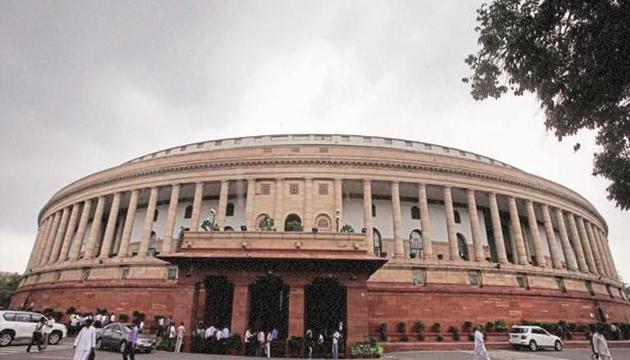Lok Sabha nod to 10% quota for poorer sections: Why all parties backed the bill
It is the final full session before elections. Politics is at its most competitive. The treasury and opposition benches disagree with each other on everything. Yet, the Bharatiya Janata Party (BJP)-led government proposed and parties vigorously opposed to the regime supported the bill.
It is a measure of how far India’s politics of reservations has travelled that no major political party dared oppose the bill to amend the constitution to set apart 10% of university seats and government jobs for economically weaker sections on Tuesday in the Lok Sabha.

It is the final full session before elections. Politics is at its most competitive. The treasury and opposition benches disagree with each other on everything. Yet, the Bharatiya Janata Party (BJP)-led government proposed -- and parties as vigorously opposed to the regime as the Congress, Samajwadi Party (SP), Bhaujan Samaj Party (BSP), Trinamool Congress and Left parties -- supported the bill.
What explains this rare convergence in the political theatre on a landmark bill that has major implications for public sector recruitment, the composition of educational institutions and social structures and power relations?
There are three broad explanations.
The first is the continued importance of communities currently in the ‘non-reserved categories’ in Indian electoral democracy. Over the last 70 years, the list of social groups benefiting from affirmative action has expanded, with the most significant shift happening with the inclusion of other backward class (OBC) groups in the reserved category. Those who could not avail of it, particularly traditional upper castes as well as dominant agrarian communities, mobilised against it. They blamed what were the larger failures of the Indian political economy--the absence of good educational opportunities and jobs --on reservations and felt they were the ‘losers’ in this new polity.
Their demands took new forms. Some asked for scrapping reservations altogether. Some wanted reservations on economic grounds. And many- like the Jats, Patidars, Marathas- wanted their communities to be added to the reservation clusters.
While unstated, the key beneficiaries of the constitutional amendment will be the relatively worse off among these communities. With deeper democratisation, their power and grip has diminished and backward groups and Dalits have become more powerful. But upper castes and agrarian communities remain a key electoral demographic for each party and to win elections, each party needs to construct wide social coalitions which include them. The Congress relied on them in the Hindi heartland till the 1990s and recent state polls saw a section return to the party. Its credible performance in Gujarat was largely due to Patidar anger over lack of reservations. The BSP relied on upper castes, particularly Brahmins , when it came to power in 2007 in UP. The SP has often relied on Thakur support. And of course for the BJP, these remain core voters-- and it was the fear of losing them that prompted this amendment in the first place.
The broad support for the amendment thus reflects the continued importance of upper castes in the electoral calculus of all major parties.
The second explanation lies in the major shift in the discourse on reservations. It may have been envisaged by the founding fathers as a tool to redress historic social injustice, particularly of Dalits and tribals, and provide them a level playing field. But over the years, reservations came to be seen as a method of power distribution and patronage, and more pertinently, economic empowerment.
Once reservation was framed as a path of upward mobility in terms of income, irrespective of the specificity of historical injustice, the claims increased. This coincided with a change in social structures. Earlier, there was almost a complete overlap between caste and class. If you were Dalit, or from a backward caste, you would be poor. If you were a Brahmin or Thakur, you would, in all probablility, be the better off in the village even if not ‘rich’.
There remains a very close correlation between caste and class. But this is not absolute anymore. There are those from Dalit and backward communities, particularly in smaller towns and urban centres, who have -- legitimately -- risen up the economic ladder, say through government employment. This has bred resentment among those from the older dominant communities. They began arguing that poverty was why reservations were given even if this was not the case. The logical corollary then was - - many who get reservations are no longer poor; but many from non-reserved groups are. Won’t economic criteria be fairer? Shouldn’t class be the basis, not caste? What about the poor ? This narrative has become so entrenched and popular that it is difficult for any party to go against it.
The third reason for the consensus is the way the amendment has been structured and the new quota system envisaged.
If the BJP had introduced this while diluting reservations for Dalits or OBCs, no other party would have been able to support it. But the government has done so without disturbing the existing architecture of reservations -- this means that even those parties who do not care much for reservations for dominant communities and see their vote base as Dalits and backwards are not perturbed. If it was a zero sum game -- a gain for one would have been at the cost of the other -- then the opposition would have been far stronger.
It is this mix of the electoral power of ‘dominant communities’, viewing reservations as an economic tool and a shift towards class-based narrative, and the manner in which the amendment is structured that has led to the widespread support that was on display in the Lok Sabha .
Get Current Updates on India News, Lok Sabha Election 2024 live, Infosys Q4 Results Live, Elections 2024, Election 2024 Date along with Latest News and Top Headlines from India and around the world.



